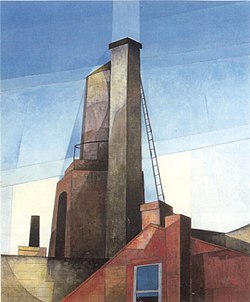
Back Precisionisme Catalan Præcisionisme Danish Präzisionismus German Precisionismo Spanish Prezisionismo Basque راستخطکاری Persian Presisionismi Finnish Précisionnisme French פרסיסיוניזם HE Precisionismo Italian

Precisionism was a modernist art movement that emerged in the United States after World War I. Influenced by Cubism, Purism, and Futurism, Precisionist artists reduced subjects to their essential geometric shapes, eliminated detail, and often used planes of light to create a sense of crisp focus and suggest the sleekness and sheen of machine forms. At the height of its popularity during the 1920s and early 1930s, Precisionism celebrated the new American landscape of skyscrapers, bridges, and factories in a form that has also been called "Cubist-Realism."[1] The term "Precisionism" was first coined in the mid-1920s, possibly by Museum of Modern Art director Alfred H. Barr[2] although according to Amy Dempsey the term "Precisionism" was coined by Charles Sheeler.[3] Painters working in this style were also known as the "Immaculates", which was the more commonly used term at the time.[4] The stiffness of both art-historical labels suggests the difficulties contemporary critics had in attempting to characterize these artists.
- ^ Milton Brown, American Painting from the Armory Show to the Depression (Princeton: Princeton University Press, 1955), pp. 114–115.
- ^ Gail Stavitsky, Precisionism in America, 1915–1941: Reordering Reality (New York: Abrams, 1994), p. 21.
- ^ [Styles, schools and movements, published by Thames & Hudson 2002 Amy Dempsey]
- ^ Stavitsky, p. 19.
© MMXXIII Rich X Search. We shall prevail. All rights reserved. Rich X Search